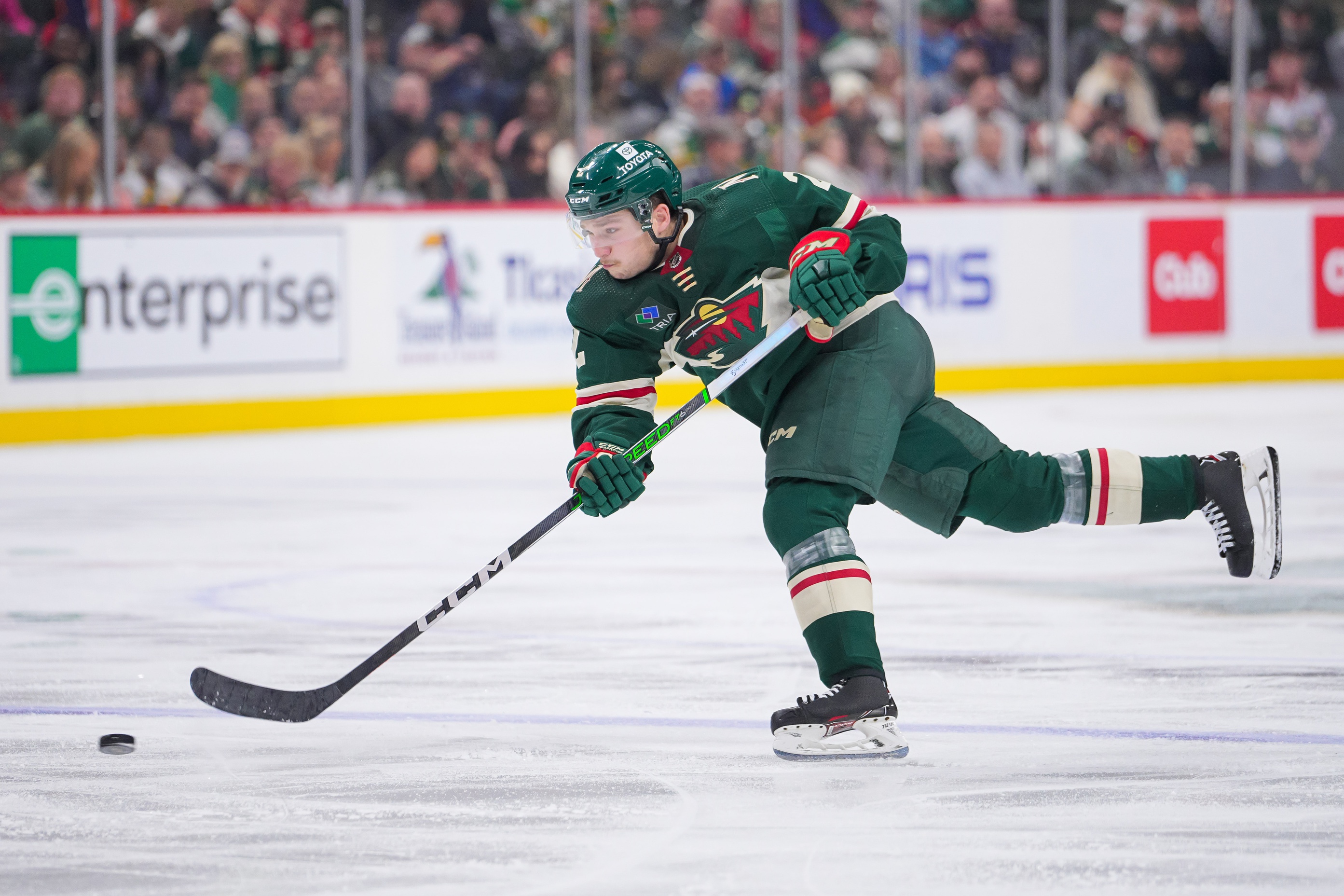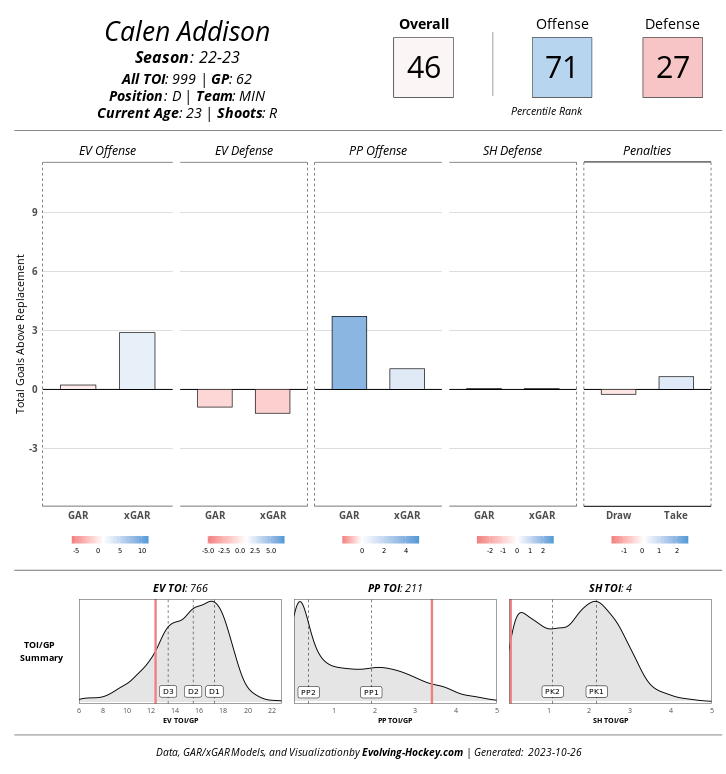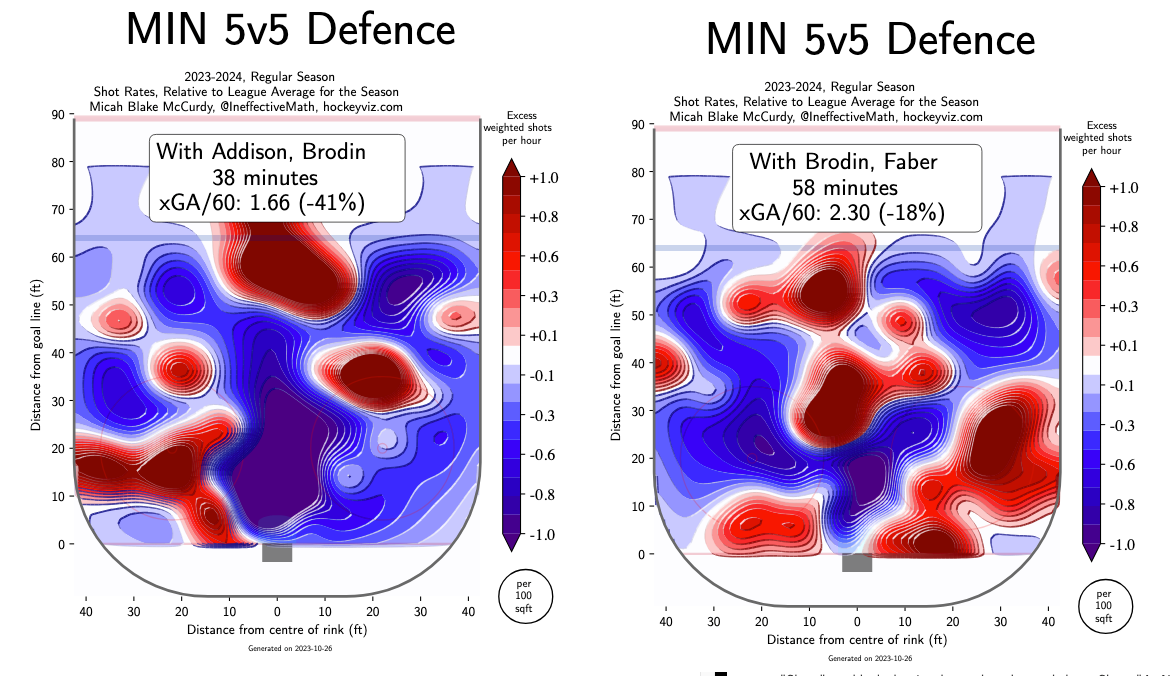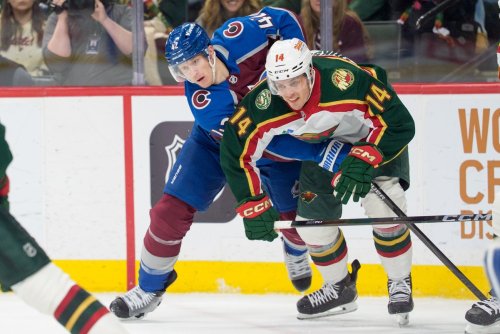
Brock Faber may have largely stepped into Matt Dumba's on-ice role of being a top-four defenseman for the Minnesota Wild. Still, it's Calen Addison who is Dumba's true successor. His offense-heavy profile mirrors that of a young Dumba, with all of the upside and criticism that comes with it. Remarkably, Addison is also Dumba's heir apparent for constant presence in trade rumors.
Addison, 23, returned to Minnesota and entered the year trying to prove he could stick in the lineup after the Wild healthy-scratched him for most of the final two months of last season. He quarterbacked the power play competently up until that point, racking up 29 points in 62 games as a defenseman.
Still, his struggles at even strength were too hard for Dean Evason to ignore. Bad luck exacerbated some of his struggles, with an .891 save percentage behind him magnifying his mistakes. But even if his minus-17 rating exaggerated the matter, it was hard to argue that he was a good defensive defenseman.

Maybe the Wild could have lived with that, but Addison wasn't an offensive factor at 5-on-5 play. The quick, confident puck moving he displayed on the power play simply didn't translate. He couldn't get his forwards the puck in the offensive zone, and instead hammered low-percentage shots from the point, as seen in his heat map from last year:

So Addison's job was pretty clear from the start of training camp. He was supposed to play behind Faber and Jared Spurgeon on the third pairing, keep his success on the power play rolling, and be an asset in a low-leverage role at 5-on-5.
Then Spurgeon got hurt. Alex Goligoski struggled in a top-four role in the first two games, and he also got hurt. Suddenly, the Wild were relying on Addison. In the past four games, Addison's averaged 19:52 a night, logging nearly as many 19-minute nights in this stretch (3) as he had previously in his career (5).
If you're skeptical of Addison, and Dumba before him, you can still see the warts on Addison's start. At 5-on-5 play, Addison's been on the ice for five goals against in six games. It's a small sample size, and his goaltending has once again let him down (Addison has an 875 on-ice save percentage). However, he's still giving up 3.84 goals per hour, or 146th among 175 defensemen with 60-plus minutes.
That showing might have ended with Addison on the bench had the Wild been healthy. And that's still a threat once Spurgeon returns. But we can pretty confidently say that Addison deserves to continue playing, because Addison took the scratches to heart and came to play this season.
For one, he's not letting his poor goaltending keep him in "minus" territory, at least not through six games. Minnesota is still out-scoring their opponents at 6-5 with Addison on the ice at 5-on-5. Some credit goes to a sky-high 16.3% shooting percentage. But while that will regress downward, his goalie's save percentage should rebound the opposite way. Once that happens, Addison is well-suited to thrive.
For a long time, the Wild's defensive structure made it easy to put up absurd 5-on-5 defensive numbers. Minnesota historically allows something like two expected goals (or xG) per hour, routinely finishing first or second in the NHL. If you play for the Wild, you're not giving up a lot of expected goals, no matter what.
That's not the case this year, not without Spurgeon shutting down opponents for 20-plus minutes a night, at least. Ask Jake Middleton (2.99 xGA per hour at 5-on-5) or Jon Merrill (3.60), or Dakota Mermis (3.98) how that structure is working for him.
Meanwhile, Addison leads Minnesota in that category. His 2.11 xGA/60 is ahead of Brodin (2.51) and Faber (2.61). His assignments tend to be easier than those two, though Addison has played about half of his 5-on-5 minutes with Brodin. It should also be noted that Brodin has been stingier with Addison (1.71 xGA/60) than he has with Faber (2.71).

This greatly improved defense, especially relative to the rest of the unit, has Addison playing like a top defenseman in the NHL so far. Addison currently ranks 31st of the 175 defensemen with a 56.7% xG share at 5-on-5. That compares favorably to recent top-10 picks in top-four defensemen roles such as the Ottawa Senators' Jake Sanderson (56.7%), the Columbus Blue Jackets' David Jiricek (55.1%), and the New Jersey Devils' Luke Hughes (54.6%).
Addison is also pushing the pace at 5-on-5 offensively, something he never was able to do last season. Again, the shooting will regress, but the Wild are seeing 2.77 xG per hour with him on the ice at 5-on-5. That's the most of any Wild player with 30-plus minutes in that situation. Thrust into a tougher-than-expected situation, Addison is thriving and proving he belongs in Minnesota's lineup.
It's important that we're clear on a few things. We are indeed talking about a small sample size in a role that (once again) isn't the tough shutdown gig Faber faces. We're not saying that Addison is the best defenseman on the team. Nor are we saying that he's a flawless shutdown defenseman. He's still had some warts in his own zone, and that may always be the case.
Still, it's clear that Addison is delivering on exactly what Evason wanted from him. He's contributing offensively on the power play without being a liability at 5-on-5. Addison is engaged and motivated, and his improvement shows that he made progress both physically and mentally this summer. Addison is not only here to play. If he keeps this up, he should be here to stay.
Think you could write a story like this? Hockey Wilderness wants you to develop your voice, find an audience, and we'll pay you to do it. Just fill out this form.
-
 1
1
-
 1
1








Recommended Comments
Join the conversation
You can post now and register later. If you have an account, sign in now to post with your account.
Note: Your post will require moderator approval before it will be visible.